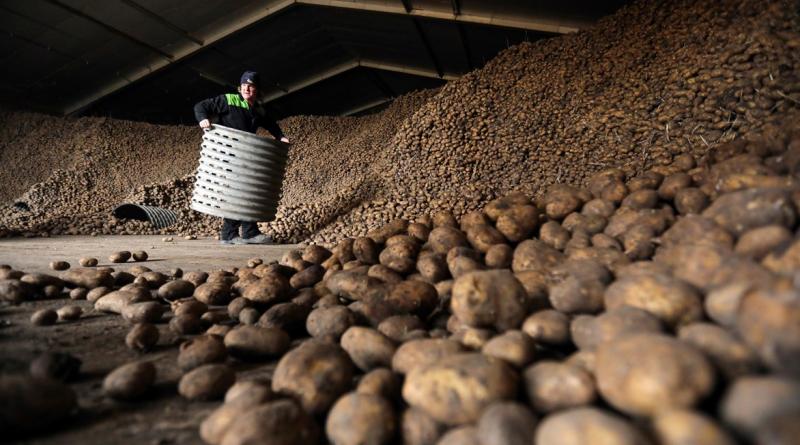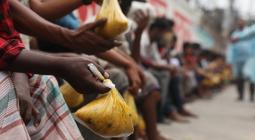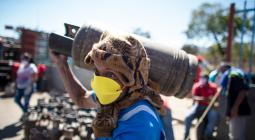Without food, there can be no exit from the pandemic.

Countries must join forces to avert a global food crisis from COVID-19.
The coronavirus pandemic has laid many things bare, none more so than how interconnected our world is. The impact of globalization is most obvious in the stuttering supply chains that threaten food security worldwide. Maintaining or reweaving these webs is going to take technology, innovation and political determination.
As chief economist at the Food and Agriculture Organization of the United Nations (FAO), I fear that few countries have recognized that their measures to contain the virus and buffer economic shocks must be adjusted to keep food flowing. Without food, there can be no health. The policy prescriptions are straightforward, and isolationism can form no part of it. Countries must work together, not throw up trade walls and bar essential workers from crossing borders.
Global food-supply chains are already buckling. In India, farmers are feeding strawberries to cows because they cannot transport the fruit to markets in cities. In Peru, producers are dumping tonnes of white cocoa into landfill because the restaurants and hotels that would normally buy it are closed. And in the United States and Canada, farmers have had to pour milk away for the same reason. Legions of migrant workers from Eastern Europe and North Africa are trapped at borders, instead of harvesting on the farms of France, Germany and Italy. The United States, Canada and Australia all rely heavily on seasonal farmworkers who are unable to travel because of virus restrictions, including the suspension of routine visa services by some embassies. There are also concerns that foreign workers could import cases of infection. Crops are rotting in the fields.
Fortunately, cereal harvests are expected to be good this year. Already, the world’s stockpile of maize (corn) is more than twice what it was in 2007 and 2008, when severe droughts created food shortages in key exporting countries, leading to a global food crisis. Rice and soya-bean stockpiles have also increased over this period, by around 80% and 40%, respectively.

But the bounty will not help to avert food shortages if countries cannot move food from where it is produced to where it is most needed. Ships laden with cereals, fresh fruit and vegetables are docking late and their crews cannot disembark. So perishables, unable to reach wholesale markets in time, are going to waste. Wheat prices have jumped by 8% and rice prices by 25% compared with those of March last year. Meanwhile, panic buying across the world is creating more waste and affecting the quality of diets as people struggle to access fresh food. Global action on food was a challenge even before COVID-19. That countries and regions are experiencing the pandemic at different times and in different ways — from China, to Europe, the United States, India and now Africa — has created an ethos of nations acting only for themselves.
Chain reactions
That has led to chaotic chain reactions. Earlier this month, Russia, the world’s leading wheat exporter, limited wheat exports for three months to ensure that local supplies were sufficient. Although the disruption is expected to be minimal (see, for example, ref. 1), the gesture set alarm bells ringing elsewhere. It was a decision driven by a confluence of events, including the sharp drop in oil prices — this weakened the rouble against the dollar, which in turn bumped up local prices of wheat. It is the same course that Vietnam took with paddy rice in March, which is why rice prices spiked.
The pandemic has emboldened divisive arguments — such as that open borders have enabled the virus to spread, that refugees and immigrants must be kept out, and that outsourcing should end. But such political positions ignore how much nations depend on each other for staple ingredients, pesticides, fertilizers, animal feed, personnel and expertise.
What happens next depends on whether nations resist isolationist pressures. I urge them to commit to not imposing export restrictions in response to the pandemic. Instead, they should agree to eliminate tariffs and taxes to compensate for local price increases caused by currency devaluation. And they should designate workers at ports and on farms as essential personnel, protect the health of these people and ensure that they can travel and continue to work.
Collaboration is possible. The agriculture ministers of 25 Latin American and Caribbean countries signed an agreement this month to work together to guarantee food supplies in the region. Such a political declaration can pave the way for real progress. And governments and investors can benefit from more transparency and information than ever before on market conditions, through tools such as the Agricultural Market Information System (www.amis-outlook.org), which can reduce uncertainty.
Smoothing the shocks
At the FAO, we are focusing on mitigating the virus’s impact on the activities that deliver produce to people, using evidence and lessons learnt from past crises. This includes information about food-price increases and volatility2, and how access to food and nutrition was affected during recent outbreaks such as that of Ebola3. Using big data, we monitor trade and collect information on logistical issues, assess how problems have been resolved and then signal the outcome to the market to reduce uncertainty (see https://datalab.review.fao.org). For example, we know that the main delay in shipping happens during cargo unloading, which now takes three days instead of one because of labour restrictions at ports. The delay is expensive for exporters, but they make up for it with the gains from exchange rates. So global shipping is working.
We also track news in multiple languages to see how the pandemic is affecting food and agriculture. This helps countries to make policy decisions. We work with developing nations to boost food supply by analysing their agro-ecological conditions and advising when and where to plant and harvest their key commodities. We forecast how various aspects of the agricultural sector could be affected by COVID-19 — from labour and decreased demand because of falling incomes to exchange rates and inflation4.
What the pandemic has underscored is that the world must use its land and water resources sustainably, to grow essential, nutritious food in a more resilient way. One way of doing this is to cut food loss5. The world squanders about US$400 billion of food annually — an amount that could feed around 1.26 billion people a year. The wastage is equivalent to 1.5 gigatonnes of carbon dioxide emissions. (Compare that to the roughly 33 gigatonnes emitted in 2019 to produce the world’s energy.) Another priority is better treatment for smallholders and migrant workers, who form the backbone of farming. For example, small-scale operations need access to markets and help to increase productivity and incomes, which goes far beyond mere subsidies.
The pandemic is an opportunity to hit the reset button, with scientists and social scientists playing an important part. And innovation is happening: China is investing in drones, unpiloted vehicles and other agriculture technologies to reduce human contact. In Africa, mobile phones are improving access to markets, prices and weather data, as well as facilitating money transfers6. Peru is seeing the benefits of innovative legislation that has formalized the farm labour force and directly linked it to the seasonality of crops. The government now knows which farmers are affected by the lockdown and can ensure they receive the necessary support. Let us seize these huge opportunities collectively.
It is precisely because the coronavirus doesn’t respect borders that global cooperation is the only shot at defeating it. The people who are working on vaccine trials, health care, drug discovery and economic recovery must all still eat. We can either stand together or many millions will starve separately.
Nature 580, 588-589 (2020)
doi: 10.1038/d41586-020-01181-3
23 April 2020
nature





